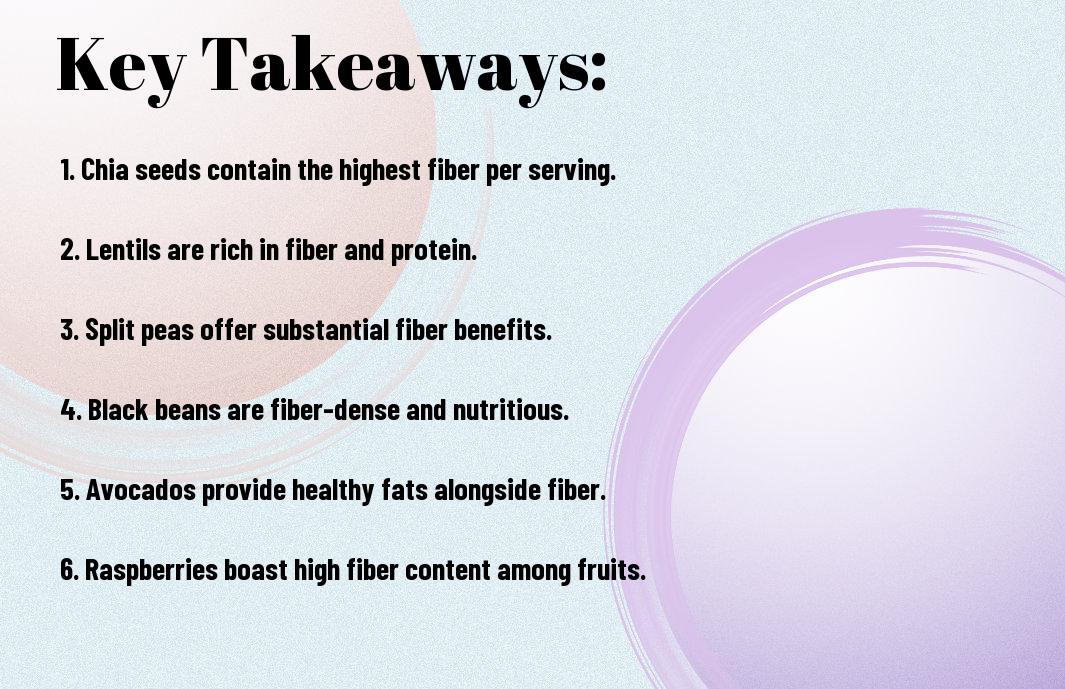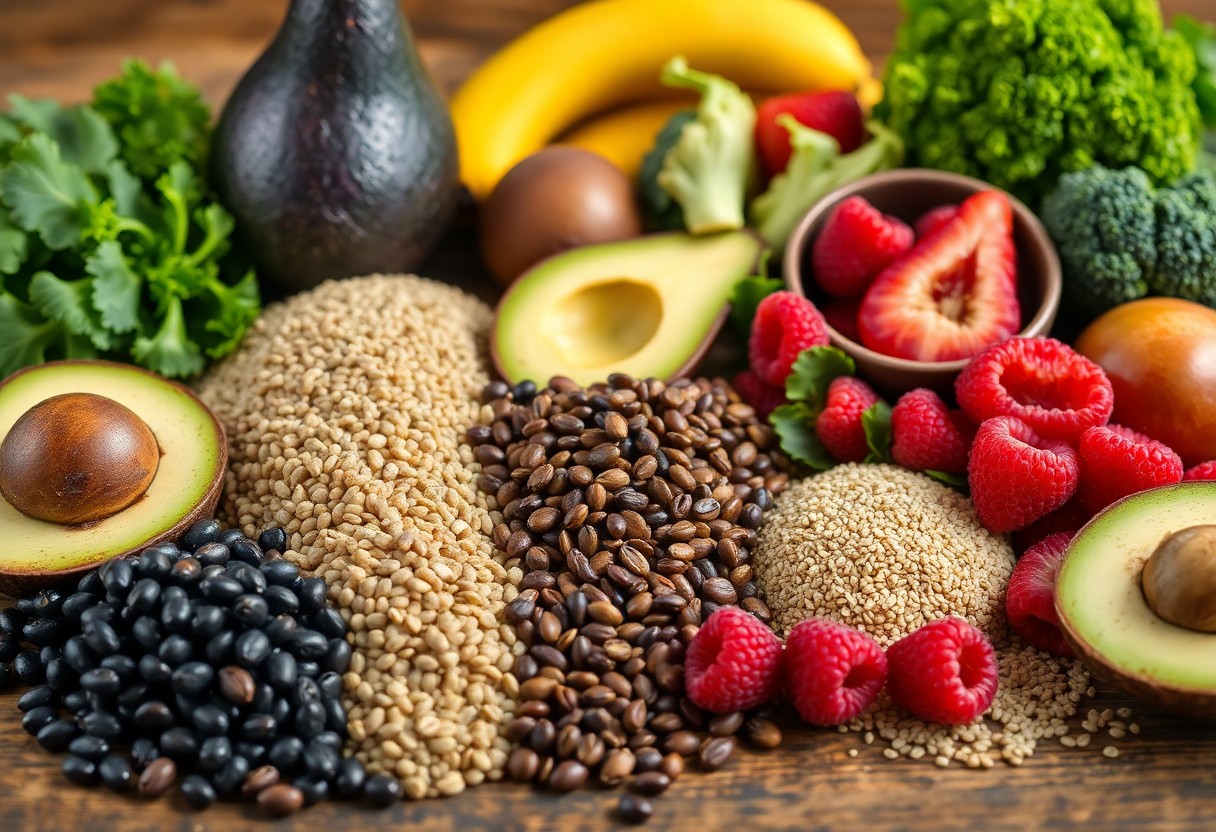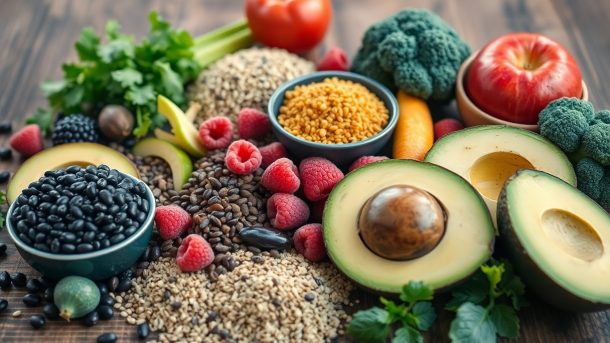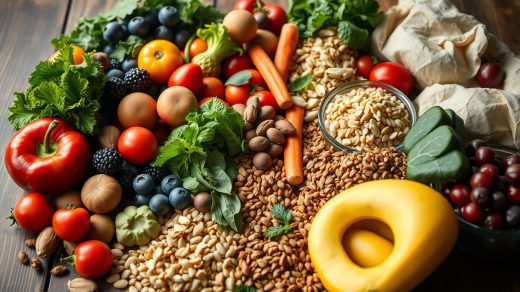Nutrition plays a key role in your overall health, and dietary fiber is one of the most necessary components for maintaining a well-balanced diet. If you’re looking to boost your fiber intake, understanding which foods pack the highest fiber content can significantly benefit your digestive health and help you feel fuller for longer. This blog post will guide you through the top high-fiber foods you should incorporate into your meals for enhanced nutrition and overall wellness.
Key Takeaways:
- Legumes: Foods such as lentils, black beans, and chickpeas are among the highest in fiber content, providing substantial health benefits.
- Fruits and Vegetables: Certain fruits like raspberries and vegetables such as artichokes and broccoli are excellent sources of dietary fiber.
- Whole Grains: Foods like oats, quinoa, and barley are packed with fiber, which supports digestive health and helps maintain a balanced diet.
Understanding Fiber
Before exploring into the highest fiber foods, it’s important to understand what fiber is and its role in your diet. Fiber, a type of carbohydrate, plays a significant role in digestive health by supporting regular bowel movements and maintaining gut health. If you’re curious about high-fiber options, check out 29 High-Fiber Foods That Support Digestive Health.
Types of Dietary Fiber
For a better grasp of fiber, it’s important to know there are two main types: soluble and insoluble. Both types contribute differently to your diet and health. Here’s a breakdown:
| Soluble Fiber | Dissolves in water and can help lower cholesterol. |
| Insoluble Fiber | Does not dissolve in water and promotes regular bowel movements. |
| Sources | Fruits, vegetables, legumes, whole grains. |
| Benefits | Supports heart health and digestive regularity. |
| Recommendations | Include a mix of both in your diet. |
After understanding the two fiber types, you can better incorporate them into your meals.
Health Benefits of Fiber
Fiber plays a significant role in maintaining your overall health. It aids digestion, helps control blood sugar levels, and can even assist in weight management. By including sufficient fiber in your diet, you’re likely to enjoy a healthier lifestyle.
This dietary component also contributes to reducing the risk of chronic diseases, including heart disease and diabetes. By incorporating a variety of fiber-rich foods, you can improve your gut health, which can lead to enhanced nutrient absorption and overall well-being.

Top Fiber-Rich Foods
Now that you understand the importance of fiber in your diet, it’s time to explore some of the top fiber-rich foods that can help you achieve optimal health. Incorporating a variety of these foods can not only boost your fiber intake but also support digestion and overall wellness. From fruits and vegetables to legumes and whole grains, you’ll find that there are plenty of delicious options available to enhance your meals.
Legumes and Pulses
Behind whole grains, legumes and pulses are among the best sources of dietary fiber. Varieties like lentils, chickpeas, and black beans pack a powerful fiber punch, helping to keep you full longer and support healthy digestion. Additionally, these foods are affordable and versatile, making them an easy addition to salads, soups, and stews.
Whole Grains
Before you probe your next meal, consider adding whole grains to your plate for an extra boost of fiber. Foods such as quinoa, brown rice, oatmeal, and whole wheat bread are not only rich in fiber but also provide a range of crucial nutrients that benefit your overall health. Whole grains can lower cholesterol levels, regulate blood sugar, and improve digestive health.
Even small changes, like swapping white rice for brown rice or choosing whole wheat pasta over regular pasta, can significantly increase your fiber intake and enhance your meal’s nutritional profile. Incorporating whole grains into your diet can help you maintain energy levels and promote a feeling of fullness, making them an excellent choice for weight management and digestive support.

Vegetables High in Fiber
Despite often being overlooked, vegetables are an excellent source of dietary fiber, which aids in digestion and supports overall health. Incorporating a variety of fiber-rich vegetables into your meals can help you meet your daily fiber goals while enhancing flavor and texture. From leafy greens to root vegetables, making these choices can significantly boost your nutrient intake and keep your digestive system functioning optimally.
Leafy Greens
Above all, leafy greens like spinach, kale, and Swiss chard are packed with fiber and necessary vitamins. These versatile vegetables can easily be added to salads, smoothies, or cooked dishes to enhance both nutrition and taste while supporting your gut health.
Cruciferous Vegetables
Across the varieties of cruciferous vegetables, you will find broccoli, cauliflower, Brussels sprouts, and cabbage, all rich in fiber. Incorporating these vegetables into your diet can help you achieve better digestive health while providing necessary nutrients.
Another benefit of cruciferous vegetables is their unique composition of antioxidants, which can help protect your body from oxidative stress. Eating a variety of these fiber-rich options can promote satiety, making them perfect for anyone looking to manage their weight while enjoying a delicious array of flavors in their meals.
Fruits That Pack a Fiber Punch
Not all fruits are created equal when it comes to fiber content. Some varieties offer a substantial amount of dietary fiber that can significantly contribute to your daily intake, helping to promote healthy digestion and keep you feeling full. Incorporating these fiber-rich fruits into your diet can enhance your overall health while satisfying your sweet tooth.
Berries
Between strawberries, raspberries, blueberries, and blackberries, berries stand out as fiber powerhouses. Just a cup of raspberries provides about 8 grams of fiber, while blackberries closely follow with 7 grams. Their vibrant colors and delicious flavors make it easy to include them in your meals or snacks, boosting your fiber intake effortlessly.
Apples and Pears
After berries, apples and pears are excellent choices to boost your fiber consumption. A medium-sized apple with its skin can provide around 4 grams of fiber, while a medium pear offers about 5 to 6 grams. Both fruits are versatile and can be enjoyed raw, added to salads, or incorporated into baked goods, making fiber intake tasty and enjoyable.
This versatility not only enhances your meals but also helps you achieve your nutritional goals. Choosing whole fruits rather than processed options ensures you get the maximum fiber benefits. Aim to keep the skins on for an added fiber boost, and consider mixing apples and pears into smoothies or oatmeal for a delicious, fiber-rich start to your day.
Nuts and Seeds as Fiber Sources
For those seeking to enhance your fiber intake, nuts and seeds are excellent options. Both offer a significant amount of fiber along with healthy fats, making them great for snacking or adding to meals. To discover 24 High-Fiber Foods For Optimal Health, consider incorporating a variety of nuts and seeds into your diet for maximum benefits.
Chia Seeds
Behind their tiny appearance, chia seeds pack a powerful fiber punch, providing around 10 grams of fiber per ounce. When you add them to your smoothies or puddings, they not only enhance the texture but also keep you feeling fuller longer, promoting overall digestive health.
Almonds and Walnuts
Seeds such as almonds and walnuts are fantastic sources of both fiber and nutrients. You can enjoy a handful as a quick snack, or sprinkle them on your salads and oatmeal for additional fiber and crunch. These nuts not only contribute to meeting your daily fiber goals but also provide heart-healthy fats for overall wellness.
This combination of fiber, protein, and healthy fats makes almonds and walnuts imperative additions to your pantry. Eating them regularly can aid in digestion, help maintain steady blood sugar levels, and support weight management, ultimately enhancing your overall health and vitality.
Tips for Increasing Fiber Intake
All you need to do is make small adjustments to your diet to boost your fiber intake effectively. Consider these strategies:
- Start your day with a high-fiber breakfast, like oatmeal or whole grain cereal.
- Incorporate beans or lentils into your salads and soups.
- Swap white bread and pasta for whole grain versions.
- Snack on fruits, vegetables, and nuts instead of processed snacks.
- Gradually add fiber-rich foods to your meals to avoid digestive discomfort.
Any effort to increase your fiber intake can lead to long-term benefits for your health.
Gradual Introduction of Fiber
About introducing fiber into your diet gradually is vital to avoid potential digestive issues. Start with a small amount and gradually increase it over several days or weeks. This will help your body adjust without causing bloating or discomfort, making the transition smoother and more manageable for you.
Pairing with Other Nutrients
With fiber-rich foods, pairing them with other vital nutrients can enhance overall health. Foods high in protein, healthy fats, and vitamins complement fiber, making meals more balanced and satisfying.
And when you consume fiber alongside other nutrients, you may find that it improves satiety, keeping you fuller longer. For instance, pair your fiber-rich fruits with a dab of nut butter for healthy fats or mix legumes with whole grains for a complete protein source. This not only helps in nutrient absorption but also supports better digestion, making your meals more enjoyable and nutritious.
To wrap up
Upon reflecting, you will find that the highest fiber foods are typically plant-based, with beans, lentils, and certain fruits and vegetables leading the pack. Incorporating these foods into your diet can significantly boost your fiber intake, promoting digestive health and overall well-being. Prioritizing high-fiber foods, such as chia seeds and whole grains, can enhance your nutrient profile and support long-term health. By making informed choices about your food selections, you empower yourself to achieve better digestive harmony and improved vitality.
FAQ
Q: What is the highest fiber food?
A: The highest fiber food is typically considered to be chia seeds, which offer about 34 grams of fiber per 100 grams. Other notable high-fiber foods include split peas, lentils, black beans, and artichokes, all of which are excellent sources of dietary fiber.
Q: How can I incorporate high fiber foods into my diet?
A: You can incorporate high-fiber foods into your diet by adding beans and legumes to soups and salads, including whole grains like quinoa and barley in your meals, snacking on nuts and seeds, and consuming plenty of fruits and vegetables such as raspberries, pears, and broccoli. Smoothies that include spinach or kale can also boost fiber intake.
Q: What are the health benefits of consuming high fiber foods?
A: Consuming high-fiber foods has numerous health benefits, including improved digestion, better blood sugar control, reduced cholesterol levels, and enhanced weight management. High-fiber diets can also lower the risk of developing chronic diseases, such as heart disease and certain types of cancer.
Q: Can I get enough fiber from just fruits and vegetables?
A: While fruits and vegetables are excellent sources of fiber, relying solely on them may not provide enough fiber for optimal health. It’s beneficial to include a range of high-fiber foods such as whole grains, legumes, nuts, and seeds in your diet to meet the recommended daily fiber intake, which is about 25 grams for women and 38 grams for men.
Q: Are there any risks associated with consuming too much fiber?
A: Yes, consuming too much fiber, especially in a short period, can lead to digestive discomfort, bloating, gas, and cramps. It is advisable to increase fiber intake gradually and ensure adequate fluid consumption to help manage these effects. Always consult a healthcare provider if you experience severe discomforty after dietary changes.



